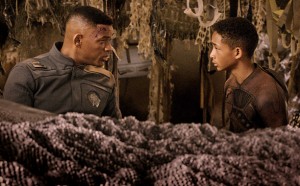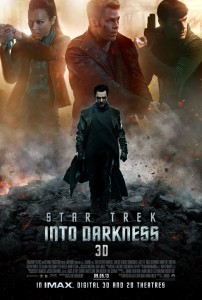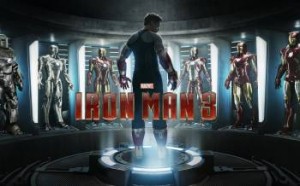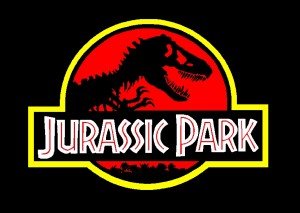After Earth
Posted on May 30, 2013 at 6:00 pm
 “After Earth” goes off the rails in the first minute as Jaden Smith (the “Karate Kid” remake, “The Pursuit of Happyness”) opens the story with a near unintelligible voice-over narration with some mishmash about how a thousand years before all humans were evacuated from Earth because the environment had become uninhabitable (critic on board so far) and then some predatory monsters evolved (still with you) who are blind but track by smelling fear (starting to lose me) and can only be defeated by “ghost fighters” who somehow are not afraid to fight them but still haven’t figured out that with all the cool technology they have invented, it might be good to have some sort of phaser-style assault weapon rather than continuing to fight them with what are basically cavemen-style spears, or technology of 20,000 years ago (critic has left the building). Will Smith has done to Jaden with this movie what Rebecca Black’s parents did to her with “Friday.” At about 50,000 times the cost.
“After Earth” goes off the rails in the first minute as Jaden Smith (the “Karate Kid” remake, “The Pursuit of Happyness”) opens the story with a near unintelligible voice-over narration with some mishmash about how a thousand years before all humans were evacuated from Earth because the environment had become uninhabitable (critic on board so far) and then some predatory monsters evolved (still with you) who are blind but track by smelling fear (starting to lose me) and can only be defeated by “ghost fighters” who somehow are not afraid to fight them but still haven’t figured out that with all the cool technology they have invented, it might be good to have some sort of phaser-style assault weapon rather than continuing to fight them with what are basically cavemen-style spears, or technology of 20,000 years ago (critic has left the building). Will Smith has done to Jaden with this movie what Rebecca Black’s parents did to her with “Friday.” At about 50,000 times the cost.
You can see where this comes from. Will Smith is credited with the idea, and it is structured as an allegory for the wrenching moment of parenting he is at with his son, that precarious balance between wanting to protect them and needing them to have the courage, integrity, and skill to take care of themselves. Smith senior plays General Cypher Raige (these names are really over the top), a taciturn, demanding man who has spent more of his son’s life away from home than with him. Jaden Smith plays Cypher’s son Kitai, who, just as his father is returning home is notified that he has not qualified as a cadet. He is desperate to prove himself to his father, but due to a past trauma that will be revealed in great detail, is not sure of himself. Cypher decides the thing to do is to bring Kitai along on movie cliché number three, the “one last mission.” And, in movie cliché number two, something unexpectedly goes very, very wrong. And in movie cliché number one, two people who don’t know each other very well learn to respect and appreciate one another.
The spaceship crashes, everyone else is killed, Cypher is injured badly, and the only way for them to survive is for Kitai to make a very dangerous trip, by himself, to a remote location, so ET can phone home and they can get rescued. This is the part of the movie where the characters lay out the SWOT (strengths, weaknesses, opportunities, and threats), so we can see how they play out over the rest of the story. Are the little ampules for coating the lungs so Kitai can breath absolutely necessary? (Props to the foley team here; the sound these little disks make as he sucks them in are excellent.) Well, somehow Kitai will have to face a shortage. Is the holographic communications system attached to Kitai’s sleeve the only way his father can direct him to the communications disk that is their only hope of calling for help? Somehow it will have to break. And then there are the creatures “all evolved to kill humans” Kitai will run into along the way, plus various other difficulties, one requiring a “Pulp Fiction”-esque injection into the heart.
I have cherished the notion, as M. Night Shyamalan has gone from skillful, absorbing films like “The Sixth Sense” to gimmicky and increasingly self-aggrandizing claptrap (“Lady in the Water,” “The Last Airbender”) that some day we would again see his gift for cinematic storytelling. At times, he has shown an almost Spielbergian understanding of the language of film. But here, even his camera placement is pedestrian. And it is almost as though he sets out to make the worst possible use of his actors. Will Smith’s endless appeal comes from his energy and charm. All of that is tamped down here as he plays a rigid officer who cannot seem to decide if he is talking to his son or issuing orders. Jaden Smith showed himself to be a gifted performer with a nice easiness on camera, but here he is poorly directed. A far better director and a more experienced actor would have a hard time making so much time alone on screen work. Even Tom Hanks had Wilson to talk to. By the time we get to the monster, it is just a relief to know it is almost over.
Parents should know that this film includes pervasive peril and violence, human and animal characters in peril, injured, and killed, some graphic injuries and dead bodies, family member gored by scary monster, snake, spider, falls, and some disturbing images.
Family discussion: How does Moby Dick relate to this story? What do we learn from the way the characters evaluate their resources and options? Do you agree with the General’s distinction between danger and fear?
If you like this, try: “Enemy Mine”




